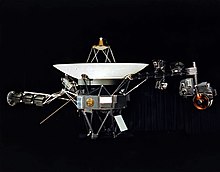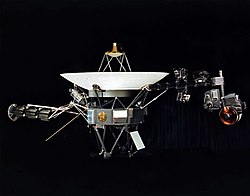Mezihvězdný let
Mezihvězdným letem se označuje kosmický let mezi hvězdami. Největším problémem mezihvězdného letu jsou obrovské vzdálenosti mezi hvězdami. Do dnešní doby bylo navrženo mnoho konceptů mezihvězdných kosmických sond. Z finančních a technických důvodů nebyl do dnešních dnů žádný realizován. Do dnešních dnů byly vypuštěny pouze sondy ke planetám.

Sondy Pioneer 10, Pioneer 11, Voyager 1, Voyager 2 a New Horizons lze označit za mezihvězdné sondy, Zmíněné sondy opustily či opustí na věčné časy Sluneční soustavu. Díky jejich velice nízké rychlosti v porovnání s rychlostí světla bude trvat statisíce let, než se přiblíží k jiné hvězdě.
Následuje tabulka kosmických sond mířících ven ze Sluneční soustavy:
| Kosmická sonda | Rok vypuštění | Směr, vzdálenost, rychlost (vůči Slunci, 15.1.2014) | funkční? |
|---|---|---|---|
| Pioneer 10 | 1972 | Aldebaran - Taurus, 110,1 AU, 2,5 AU/rok | ne |
| Pioneer 11 | 1973 | Aquila - Sagittarius, 89,6 AU, 2,4 AU/rok | ne |
| Voyager 1 | 1977 | ? - Souhvězdí Žirafy, 126,6 AU, 3,6 AU/rok | ano |
| Voyager 2 | 1977 | ? - Sirius, 103,8 AU, 3,3 AU/rok | ano |
| New Horizons | 2006 | ?, 28,5 AU, 3,1 AU/rok | ano |
Pozn.: Měřeno rychlostí světla, Voyager 1 je od Slunce vzdálen 0,73 „světelného dne“, tedy 0,004 světelného roku.
Úskalí

Jedním z problémů dosažení dostatečných rychlostí k cestování je dlouhodobé působení zrychlení. Dalším problémem je mezihvězdný prach a plyn, který i přes nízké koncentrace (téměř vakuum) může při větších rychlostech značně zahřívat a poškozovat kosmickou loď.[1] Lidská posádka by byla vystavena kosmickému záření a silně by trpěla rakovinou.[2]
Související články
Reference
- ↑ HOANG, Thiem; LAZARIAN, A.; BURKHART, Blakesley; LOEB, Abraham. The interaction of relativistic spacecrafts with the interstellar medium. S. 5. The Astrophysical Journal [online]. 2017-02-27. Roč. 837, čís. 1, s. 5. Dostupné online. ISSN 1538-4357. (anglicky)
- ↑ Animal study suggests deep space travel may significantly damage GI function in astronauts. phys.org [online]. 2018-10-01 [cit. 2021-12-29]. Dostupné online. (anglicky)
Média použitá na této stránce
NASA photograph of one of the two identical Voyager space probes Voyager 1 and Voyager 2 launched in 1977.
The 3.7 metre diameter high-gain antenna (HGA) is attached to the hollow ten-sided polygonal body housing the electronics, here seen in profile. The Voyager Golden Record is attached to one of the bus sides.
The angled square panel below is the optical calibration target and excess heat radiator.
The three radioisotope thermoelectric generators (RTGs) are mounted end-to-end on the left-extending boom. One of the two planetary radio and plasma wave antenna extends diagonally left and down, the other extends to the rear, mostly hidden here. The compact structure between the RTGs and the HGA are the high-field and low-field magnetometers (MAG) in their stowed state; after launch an Astromast boom extended to 13 metres to distance the low-field magnetometers.
The instrument boom extending to the right holds, from left to right: the cosmic ray subsystem (CRS) above and Low-Energy Charged Particle (LECP) detector below; the Plasma Spectrometer (PLS) above; and the scan platform that rotates about a vertical axis.
The scan platform comprises: the Infrared Interferometer Spectrometer (IRIS) (largest camera at right); the Ultraviolet Spectrometer (UVS) to the right of the UVS; the two Imaging Science Subsystem (ISS) vidicon cameras to the left of the UVS; and the Photopolarimeter System (PPS) barely visible under the ISS.
Suggested for English Wikipedia:alternative text for images: A space probe with squat cylindrical body topped by a large parabolic radio antenna dish pointing upwards, a three-element radioisotope thermoelectric generator on a boom extending left, and scientific instruments on a boom extending right. A golden disk is fixed to the body.Autor: P. Fraundorf, Licence: CC BY-SA 4.0
This plot illustrates how a spaceship capable of 1 g acceleration for 100 years can power a round trip to most anywhere in the visible universe, and back in a lifetime or less. Additional time will have elapsed on earth by the time that you return. This advantage of constant proper acceleration in a relativistic world arises because proper velocity change is proportional to acceleration times the change in map rather than traveler time. As those two begin to differ, the advantage (over the dotted straight line above) emerges. Of course, building a spaceship that can do this is another story.

